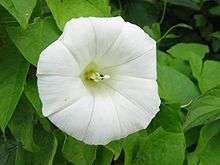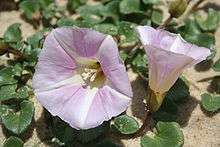Calystegia
| Calystegia | |
|---|---|
 | |
| Calystegia sepium | |
 | |
| Calystegia soldanella | |
| Scientific classification | |
| Kingdom: | Plantae |
| (unranked): | Angiosperms |
| (unranked): | Eudicots |
| (unranked): | Asterids |
| Order: | Solanales |
| Family: | Convolvulaceae |
| Genus: | Calystegia R.Br. |
| Species | |
|
See text | |
Calystegia (bindweed, false bindweed, or morning glory) is a genus of about 25 species of flowering plants in the bindweed family Convolvulaceae. The genus has a cosmopolitan distribution in temperate and subtropical regions, but with half of the species endemic to California. They are annual or herbaceous perennial twining vines growing to 1-5 m tall, with spirally arranged leaves. The flowers are trumpet-shaped, 3-10 cm diameter, white or pink, with a sometimes inflated basal calyx.
The genus bears much similarity to a related genus Convolvulus, and is sometimes combined with it; it is distinguished primarily by the pollen being smooth, and in the ovary being unilocular.
Some of the species, notably Calystegia sepium and C. silvatica, are problematic weeds, which can swamp other more valuable plants by climbing over them, but some are also deliberately grown for their attractive flowers.
Calystegia species are used as food plants by the larvae of some Lepidoptera species including Bedellia somnulentella (recorded on C. sepium) and Small Angle Shades.
The name is derived from two Greek words kalux, "cup", and stegos, "a covering", meaning "a covering cup". The stem is creeping over the ground, not winding or hardly winding. The leaves are dark green and reniform. The petioles are ovate or elleptical. The corolla is pink or pale purplish, with 5 white stripes.
- Selected species
- Calystegia affinis
- Calystegia atriplicifolia – Nightblooming False Bindweed
- Calystegia catesbiana – Catesby's False Bindweed
- Calystegia collina – Coast Range False Bindweed
- Calystegia hederacea – Japanese False Bindweed
- Calystegia japonica – Japanese Bindweed
- Calystegia longipes – Paiute False Bindweed, Plateau Morningglory
- Calystegia macaunii – Macoun's False Bindweed
- Calystegia macrostegia – Island False Bindweed
- Calystegia malacophylla – Sierra False Bindweed
- Calystegia occidentalis – Chaparral False Bindweed
- Calystegia peirsonii – Peirson's False Bindweed
- Calystegia pellita – Hairy False Bindweed
- Calystegia pulchra – Hairy Bindweed
- Calystegia purpurata – Pacific False Bindweed
- Calystegia sepium – Large Bindweed, Hedge Bindweed, Bearbind, Hedgebell
- Calystegia silvatica – Great Bindweed, Shortstalk Bindweed
- Calystegia soldanella – Sea Bindweed, Seashore False Bindweed, Beach Morning Glory
- Calystegia spithamaea – Low False Bindweed, Upright Bindweed
- Calystegia stebbinsii – Stebbins' False Bindweed, Stebbins' Morning Glory
- Calystegia subacaulis – Hillside False Bindweed
- Calystegia tuguriorium – New Zealand Bindweed, Pōuwhiwhi, Pōwhiwhi, Rarotawake
References
External links
![]() Media related to Calystegia at Wikimedia Commons
Media related to Calystegia at Wikimedia Commons